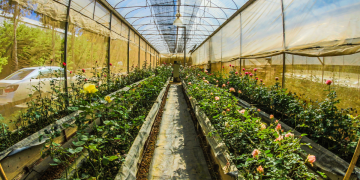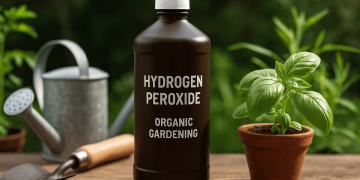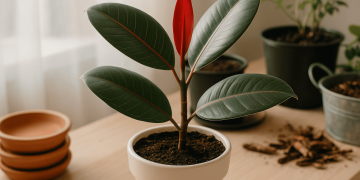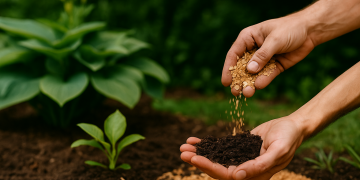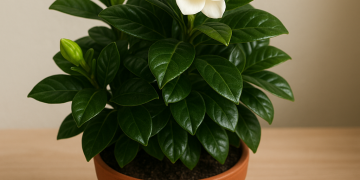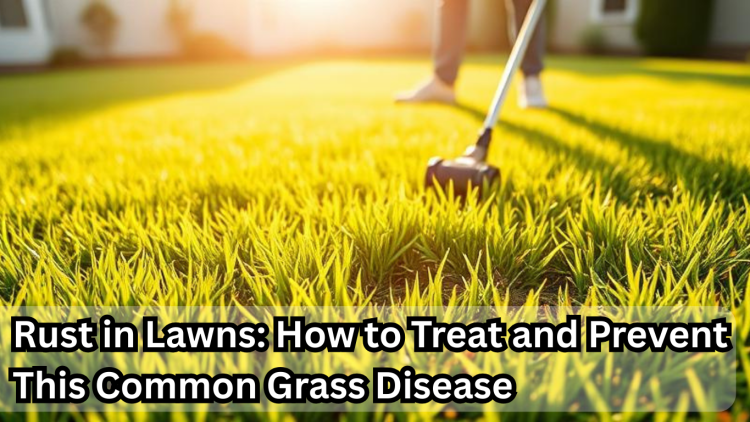Late summer and fall are prime seasons for lawn diseases like rust to appear. The good news? With timely mowing, balanced fertilization, and a bit of vigilance, rust can often be kept in check.
One of the biggest mistakes homeowners make is overlooking the early hints, tiny orange specks of dust on the blades that are easy to dismiss.
The problem is, those subtle spots can spread like watercolor bleeding across a page. What starts small can quickly turn into large, weak patches that may take months to recover. Left untreated, the overall health of your turf takes a nosedive.
The silver lining: recovery is possible. Knowing how to treat rust in lawn not only saves your grass now but also helps prevent repeat outbreaks later.
Stick around, you’ll see why in lawn care, prevention almost always beats repair.
Table of Contents
ToggleWhat Exactly is Lawn Rust Fungus?
Lawn rust is a fungal disease that usually strikes turfgrass when it’s already under stress. The main culprits belong to the Puccinia species, which thrive when grass is low on nutrients, especially nitrogen, and when moisture and poor airflow create the perfect breeding ground.
The infection spreads through microscopic urediniospores, tiny particles that form on the blades. They’re so light that a breeze, a pair of shoes, or even a quick stroll across the yard can carry them from one patch to another.
What you actually see on the grass is a dusting of fine, rust-colored powder, masses of reproductive spores ready to hitch a ride. No wonder the disease seems to “explode” once conditions favor it. It’s a bit like flour in the kitchen: a small spill quickly spreads everywhere.
Before diving into the reasons lawns become vulnerable, let’s look at how to treat rust in lawn so you can act before it gets out of hand.
How to treat rust in lawn
Natural remedies for lawn rust are usually the first and smartest step before bringing in chemicals. They’re easier on the budget, kinder to the soil, and often give the turf extra resilience against future stress.
That said, whether you go for an organic approach or a stronger lawn disease treatment, the secret lies in consistency. Regular care builds long-term resistance, while one-off fixes rarely hold up.
Here’s a clear breakdown of both paths you can take:
| Organic Treatment | Chemical Treatment |
|---|---|
| 1. Regular mowing keeps spores from spreading and lowers the risk of reinfection, especially if clippings are disposed of properly. | 1. Apply propiconazole (a systemic fungicide) carefully. It targets fungal cells in turfgrass when used exactly as directed. |
| 2. Sawdust composted with manure helps boost soil microbes that naturally compete with lawn diseases. | 2. EPA-approved fungicides such as myclobutanil, chlorothalonil, or azoxystrobin are reliable options. |
| 3. Yucca extract works as a natural wetting agent, improving soil moisture balance and cutting down fungal-friendly conditions. | 3. Granular fungicides penetrate soil gradually, offering extended protection when applied correctly. |
| 4. Neem cake powder enriches the soil with compounds that may have antifungal effects while supporting root health. | 4. Preventive-rate fungicide applications lower infection risk. For active outbreaks, full rates are needed, always stick to recommended intervals. |
| 5. Volcanic rock dust adds silica, reinforcing cell walls so grass is less prone to fungal stress. | 5. Avoid drift onto ornamental plants, since some fungicides may harm non-turf vegetation. |
When you look at the table, it’s clear: organic methods work best as your shield of prevention, while chemical options are more of a last-resort weapon for tough or recurring outbreaks.
Why Lawns Are Vulnerable: 5 Reasons!
Several everyday factors, like excess shade, lingering moisture, or weak soil, create the perfect playground for fungal diseases.
Here are the main reasons your lawn may be vulnerable to rust:
Humid Weather
When the air stays damp for too long, grass blades struggle to dry after rain or watering. Think of it as walking around in wet socks: uncomfortable and an open invitation for problems. Spores thrive in that extra moisture, germinating more easily even if you’re mowing properly.
Poor Soil Nutrition
A hungry lawn is a weak lawn. Without key nutrients like nitrogen, potassium, and iron, grass loses its vigor.
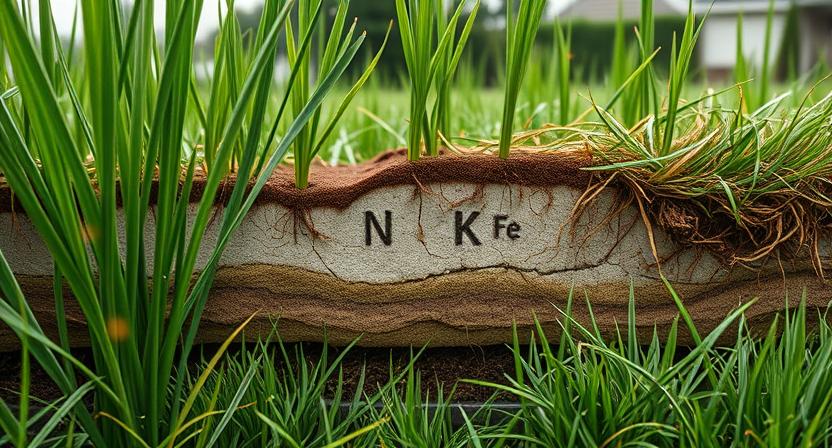
Nitrogen fuels green growth, while potassium strengthens roots and boosts natural defenses. Without them, turf becomes a soft target for fungi.
Drought Stress
Lack of water stresses turfgrass, slows growth, and weakens its defenses. In this state, spores settle in more easily. Drought isn’t just a climate issue, it lowers the lawn’s immune system, making invasion much more likely.
Irregular Mowing
Skipping or overdoing mowing encourages thatch buildup and shaded damp spots, both ideal for fungi. Over time, this also weakens the root system, leaving the lawn less able to bounce back.
Seasonal Stress
Changing seasons bring swings in moisture and temperature that grass struggles to adapt to. Summer heat can scorch blades, leaving bare patches that fungi happily colonize.
Put simply: when turf is stressed, by weather, soil, or maintenance, fungi see an open door. Keeping grass dense, well-fed, and ventilated closes that door before rust gets a foothold.
Warning Signs in Your Turf!

Lawn disease treatment is the second line of defense for a healthy lawn—early detection is the first. By recognizing the initial symptoms, homeowners can act before rust spreads widely and becomes more difficult to manage.
The key question: what should you look for?
Here are the most common signs of lawn rust and similar turf problems:
Lawn disease treatment is your backup plan. The real first line of defense is spotting problems early—before rust takes over and becomes a season-long headache.
So, what should you be watching for? Here are the top warning signs:
1. Orange or Rust-Colored Powder
Notice orange dust on your shoes after a walk through the grass? That’s a giveaway. On the blades, it looks like fine rust or chalk that rubs off easily. At this stage, check your irrigation habits, if the lawn stays wetter than it should, aeration can help drainage and cut down fungal pressure.
2. Slow Grass Growth
If your lawn feels stuck, barely growing despite regular care,it may be under stress from fungi, pests, or poor soil. Remove diseased clippings to stop spores from spreading, and hold off on overwatering, over-fertilizing, or adding chemicals until you’ve nailed the cause.
3. Weak Turf Quality
As the old saying goes:
“What you see above ground reflects what’s below.”
Thinning or patchy turf is often a root-level problem, linked to stress or nutrient imbalance. The fix? Consistent mowing, soil improvements, and if needed, targeted fungicide use to restore balance.
👉 The sooner you recognize these signs, the easier it is to turn things around. Think of it as catching a cold: early action keeps it from turning into something much worse.
Natural Remedies for Lawn Rust
When it comes to managing rust without chemicals, a set of cultural and organic practices can go a long way. These methods not only make the lawn less inviting for fungi, but also improve soil health and strengthen turfgrass over time. Think of them as giving your grass a stronger immune system rather than just treating symptoms.
Watering smartly
Watering at night is like leaving wet clothes on a chair, they stay damp for hours, and problems multiply. Fungi thrive under the same conditions. That’s why it’s best to irrigate in the early morning, when sunlight can dry the blades quickly.
Applying a light mulch layer after watering can help reduce evaporation and keep soil moisture stable without drowning the grass.
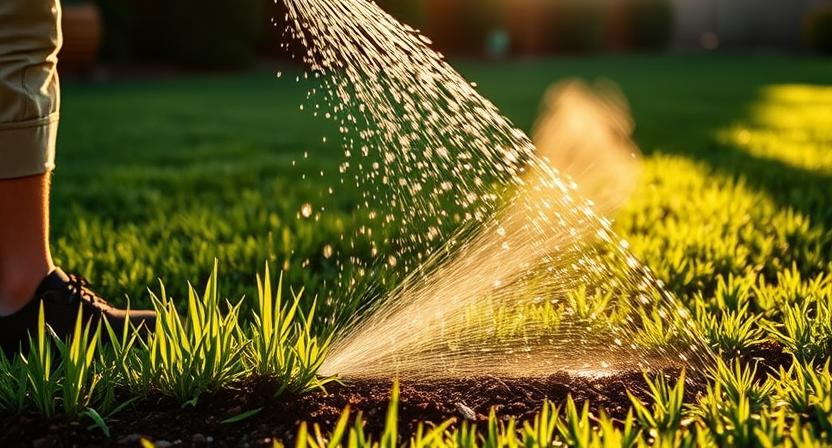
Another key detail: aim water at the soil, not the leaves. Shallow watering only wets the surface, encouraging fungal growth. Deep root hydration, on the other hand, strengthens the turf and reduces stress.
Air circulation also matters. Shaded or poorly ventilated corners of the yard stay wetter for longer, creating pockets where rust can spread. Pairing smart watering with regular mowing and light pruning of surrounding plants helps keep airflow steady.
Mowing Techniques
Maintaining the right grass height is one of the simplest ways to reduce stress and block fungal infections. Cutting too short leaves turf exposed and weak, while letting it grow too tall encourages thatch buildup and creates damp, shaded spots.

A consistent mowing schedule is best. For many grass species, keeping the height between 1.5 and 2 inches works well, but always check the ideal range for your lawn type. Think of mowing not as a drastic haircut but as a steady trim that helps the grass stay resilient.
Fertilizer Boost
Balanced fertilization strengthens turf and enhances its ability to resist disease. Nitrogen, phosphorus, and potassium are the main nutrients that support lawn vigor, while other elements like magnesium also play a role.
Healthy lawns resist rust more naturally. Balanced fertilization provides the nutrients turf needs to recover from stress and fight fungal pressure. The “big three” are nitrogen, phosphorus, and potassium:
- Nitrogen supports chlorophyll production and lush green growth.
- Phosphorus boosts root development.
- Potassium strengthens cell walls and improves natural resistance to stress and disease.

Magnesium and other micronutrients also play roles in turf metabolism, though their impact is secondary compared to the big three. The real key is balance: over-fertilization can backfire, disrupting soil structure and making the lawn more vulnerable.
Always apply fertilizers at the recommended rate, preferably with a spreader to ensure even distribution. Uneven feeding creates weak spots, prime real estate for rust.
Aeration & Dethatching
Aeration is like opening the windows of the soil: it lets roots breathe, improves water penetration, and helps nutrients reach deeper layers. Dethatching, on the other hand, removes the dense layer of dead grass and debris that can smother turf and trap excess moisture.
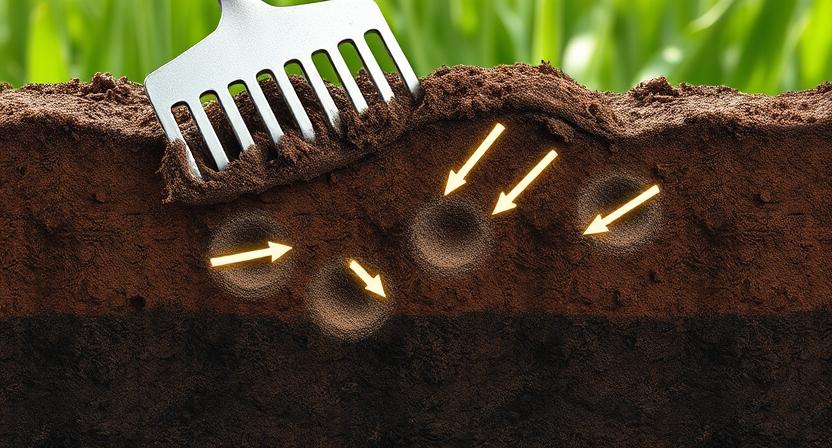
Used together, aeration and dethatching improve lawn structure and reduce conditions fungi love. They also make fertilizer applications more effective, since nutrients reach the roots instead of sitting on the surface.
Organic Fungicide Sprays
When natural practices alone aren’t enough, soft organic sprays can provide extra support. Products like neem oil, compost tea, seaweed extract, or even baking soda solutions can create conditions that discourage fungal activity.
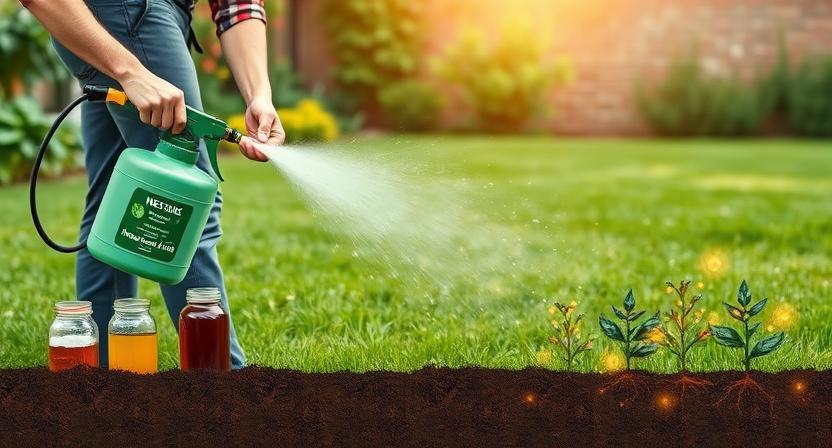
Results vary, these aren’t instant cures like strong fungicides, but they do stimulate soil microbes and improve overall turf health. Over time, this microbial balance makes it harder for rust to spread unchecked.
In summary, natural remedies for lawn rust are less about quick fixes and more about building resilience. Smarter watering, steady mowing, balanced feeding, and improved soil structure create an environment where turf thrives and fungi struggle.
Lawn Disease Treatment: Step-by-Step Plan
Natural remedies for lawn rust only work if they’re applied consistently and at the right moment. To make things easier, here’s a step-by-step plan you can follow to bring your lawn back into balance and keep fungi from spreading:

Step 1 - Identify Symptoms
Start by playing detective. Watch for yellowing, thinning, or odd discoloration, these are the early warning lights fungi love to exploit.
- Focus your attention on small patches instead of rushing to treat the whole yard. Targeted action is far more effective.
Step 2 - Apply Cultural Controls
Once you’ve spotted the weak spots, reinforce your lawn’s defenses. Key cultural practices include:
- Watering early in the morning so grass dries quickly, adjusting frequency to rainfall and humidity.
- Avoiding mowing too short or too often, it weakens turf. And definitely skip the hottest hours of the day.
- Aerating the soil periodically to relieve compaction and boost root growth.
Step 3 - Support with Fertilization
Sometimes good habits aren’t enough, and the grass needs a boost. A slow-release nitrogen fertilizer helps turf regain vigor over time.
- Pair nitrogen with organic compost to enrich soil health.
- Always check pH, nutrients only work if the soil makes them available.
Step 4 - Use Organic Sprays
After feeding the lawn, organic sprays can bring back color and vitality. Rotation is key: switching products prevents fungi from adapting.
- Alternate between seaweed extract, neem sprays, compost tea, and kelp solutions over several weeks.
Step 5 - Consider Fungicides if Needed
If natural methods aren’t enough and the outbreak is severe, it may be time for fungicides, but use them carefully.
- Propiconazole (Banner MAXX) protects existing and new growth.
- Azoxystrobin (Heritage G) targets active spores and prevents spread.
- Chlorothalonil (Daconil Ultrex) works well in humid conditions for preventive control.
Remember: fungicides are powerful tools, but overuse breeds resistance and harms the environment. Treat them as your emergency card, not your routine.
With this plan, you go from patchy, stressed grass to a lawn that’s steadily rebuilding strength. Think of it as training your turf to fight back, rather than just putting out fires.
FAQS
Start with the basics: mowing at the right height, watering in the morning, feeding with balanced fertilizer, and aerating the soil. These cultural practices usually tip the balance back in favor of healthy turf. If rust refuses to budge, fungicides can be used, but keep them as the last card in your deck, and rotate products to prevent resistance.
Sometimes, yes. In mild cases, as the grass grows stronger with proper care, rust naturally fades. But if the infection spreads widely or lingers, you’ll likely need an extra push, like targeted fungicide applications, to bring it under control.
Not to people or pets, so no need to panic if kids or dogs play on it. The real issue is turf health. Rust slowly drains vigor, leaving orange or brown patches and making the lawn easier prey for other stresses. Think of it as a slow leak in a tire: not immediately dangerous, but harmful if ignored.
Conclusion
How to treat rust in lawn when nothing else seems to work? The plan you’ve just read is your roadmap, step by step, from spotting early patches to applying compost, organic sprays, and balanced care.
The real goal isn’t just killing spores, but building a stronger lawn that naturally resists them. Consistent mowing, smart watering, and good soil health form the everyday shield; fungicides should remain the emergency tool you keep in the back pocket.
With steady care, most lawns bounce back, often greener and tougher than before.
In the end, prevention always beats cure, and a resilient lawn is the best long-term answer to rust.

